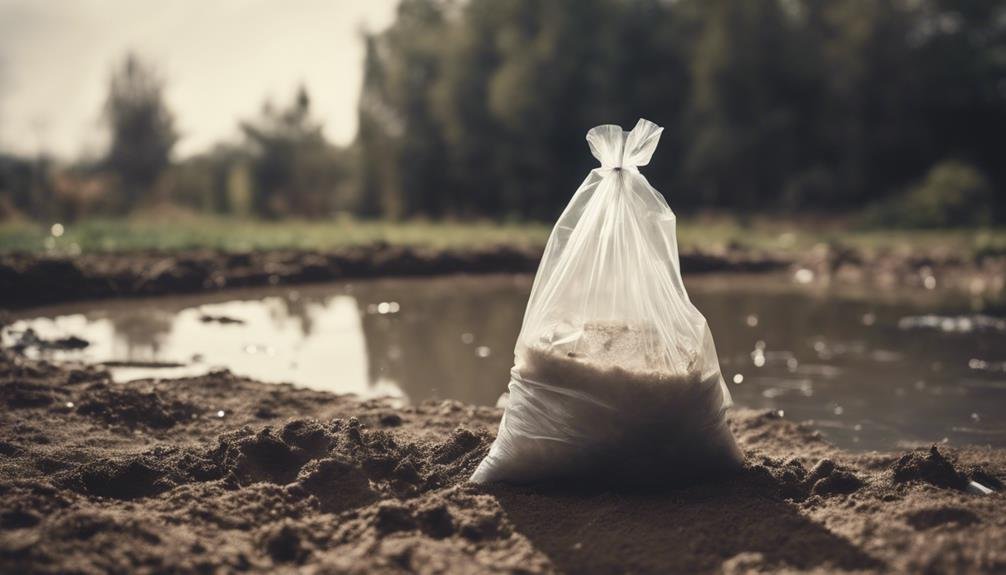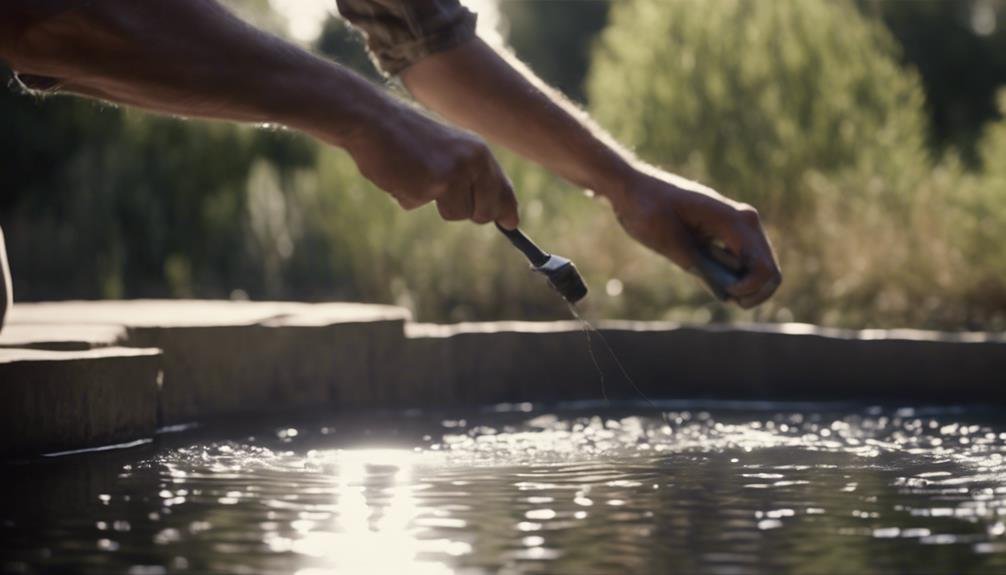Let's start by visually checking the pond for any cracks. Once identified, proceed to drain the pond using a pump or siphon.
Clear away any debris and gather necessary materials like sealants or pond putty before preparing the repair area. It is crucial to apply the chosen sealant correctly, following the specified drying times for best results.
As you refill the pond, do so gradually while keeping an eye out for any new leaks that may appear. After the repair, make sure to regularly monitor the water levels and inspect the previously seepage areas to ensure the pond's integrity is maintained over time.
By staying vigilant, you can prevent future leaks and preserve the overall condition of your pond. For a more detailed step-by-step guide on fixing leaks yourself, continue reading below.
Locate Leak Source
To fix a leak in a pond, the first step is to locate its source. Start by visually inspecting the entire pond area for cracks, holes in the liner, or any signs of water seepage. Pay close attention to the edges where the liner meets the landscape for any gaps or separations. If the leak isn't immediately visible, a more thorough leak detection test may be necessary.
For the detection test, begin by marking the water level and then waiting 24-48 hours without adding any water or experiencing rain. After this time, mark the new water level and calculate the amount of water lost. A significant loss indicates a leak.
Next, carefully examine the pond bottom by either draining the water or using an underwater camera to identify cracks, holes, or root penetrations that could be causing the leak.
Once you have identified the general area of the leak, you can use dye testing or a leak detection kit to precisely pinpoint the source. These kits contain special dyes or foaming agents that help trace the water directly to the exit point of the leak.
With the exact location of the leak determined, you can then proceed with the appropriate repair method to fix the issue.
Drain Pond Water
To drain the pond water, we've a couple of options to consider: pumping or siphoning. Pumping is the faster method, but siphoning requires less equipment.
Whichever method we choose, it's crucial to take precautions to prevent any harm to the environment or potential safety risks. It's important to consider the impact on the ecosystem and ensure that the water is safely redirected to avoid any contamination.
Water Removal Methods
When draining a pond to fix a leak, it's crucial to choose an efficient water removal method. One option is using a submersible pump, which can swiftly move large amounts of water out of the pond.
Another option is a siphon system that uses gravity to draw water through a hose. For smaller ponds, a bucket brigade can also work, but it requires more manual labor.
It's important to plan where the drained water will go, directing it away from any structures or landscapes that could be damaged. Consider any permits or regulations related to disposing of pond water, especially if it contains contaminants or organisms needing special handling.
Once the water level is sufficiently low, you can locate and repair the leak. Removing as much water as possible ensures proper access and visibility during the repair process.
Remember to prioritize safety and follow best practices for pond maintenance.
Pumping Vs Siphoning
When deciding between pumping and siphoning to remove water from a pond, various factors like pond size, desired drainage rate, and available resources should be considered. Let's weigh the advantages and disadvantages of each method to help you make an informed choice.
Pumping is often the faster and more efficient option, especially for larger ponds. A powerful pump can quickly drain large volumes of water, but it does come with added costs for electricity or fuel. Additionally, pumps tend to be noisier compared to siphons.
On the other hand, siphoning is a low-cost and simple solution that works well for smaller ponds. This method utilizes gravity to move water through a hose without the need for a power source. While siphoning is quieter than pumping, it's significantly slower. Setting up and maintaining a siphon can be challenging, especially over long distances or changes in elevation.
In conclusion, pumping is preferable for draining larger ponds quickly if you have access to an appropriate pump and power source.
For smaller ponds or tighter budgets, siphoning provides an eco-friendly alternative, albeit at a slower pace. It's essential to carefully assess your specific needs to determine which method is most suitable for you.
Drainage Precautions Needed
When draining pond water, whether using a pump or siphon, it's crucial to consider the potential environmental impact. Releasing water improperly can harm nearby ecosystems and wildlife habitats. Before discharging water, it's essential to assess if it contains any pollutants such as pesticides, fertilizers, or harmful bacteria. If pollutants are present, it's not suitable to release the water into storm drains or natural waterways.
It's important to adhere to local regulations for proper disposal methods, which may involve hiring a professional service. Even if the water is clean, it's still necessary to be cautious. Releasing large volumes of water rapidly can lead to issues like soil erosion, flooding downstream areas, or the introduction of invasive species into new environments.
The safest approach is to gradually drain the water over time into a vegetated area that can filter and absorb it slowly. Installing temporary berms or channels to direct the flow appropriately may be necessary.
Prepare Repair Area

To prepare for repairing the pond leak, we need to first drain excess water and mark the problematic area. This involves lowering the water level to expose where the leak is coming from, which can be done using a submersible pump or by siphoning out the water.
Once the leaking area is visible, it's crucial to mark it clearly with bright spray paint or stakes to ensure we know exactly where to focus our repair efforts. Removing any debris or vegetation around the leak is essential to fully expose the area that needs fixing.
Before we begin the actual repair work, it's important to gather the necessary materials. Options for repair materials include hydraulic cement, epoxy putty, or a pond liner patch kit. It's essential to carefully read the instructions provided with the chosen repair material and have all the required tools on hand, such as a trowel, putty knife, or sandpaper, depending on the repair method selected.
Properly preparing the repair area and having all the materials ready are crucial steps for ensuring a successful and lasting fix for the pond leak. Taking the time to do these initial steps thoroughly will help make the repair process smoother and more effective.
Choose Repair Method
Selecting the right method for repairing leaks efficiently is crucial. Factors such as the leak's size, location, the pond's construction materials, and the type of damage need to be considered.
For small cracks or leaks in a flexible liner, using a pond sealant or repair kit designed for that material is ideal. This involves examining the area, applying the sealant, and ensuring it cures properly.
On the other hand, larger holes or leaks in rigid ponds may require hydraulic cement or waterproof pond putty for more extensive patching. This process includes thoroughly inspecting the repair area, letting it dry completely, and carefully applying and smoothing the patching material to ensure a secure and seamless finish.
In severe cases of significant damage, draining the pond and replacing a section of the liner or shell may be necessary.
However, for most common leaks, using the right sealants and patching compounds can provide a lasting solution when applied correctly.
Apply Sealant Properly

To ensure a durable, leak-free repair, it's crucial to apply sealants correctly. Here are the essential steps to follow:
Firstly, prepare the surface meticulously by ensuring it's clean, dry, and free of any debris. It may be necessary to slightly roughen the surface to enhance adhesion.
Next, adhere strictly to the manufacturer's instructions when applying the sealant. Aim for a consistent bead or layer without any gaps or thin spots.
Allow sufficient time for the sealant to cure completely before refilling the pond. The curing time can vary, so it's advisable to refer to the product guidelines for specific recommendations.
Proper application technique is vital to ensure even coverage without leaving any voids or thin areas that could compromise the sealant's effectiveness.
It is important to consider external factors such as temperature and humidity, as they can impact curing times and adhesion. Adhering closely to the manufacturer's instructions will increase the chances of a successful and long-lasting repair.
Remember, applying too much sealant can be wasteful, while too little can lead to inadequate coverage and potential leaks.
Refill Pond Carefully
After the sealant has fully cured, it's essential to refill the pond gradually to avoid damaging the freshly applied sealant. Begin by adding a small amount of water and allow it to slowly seep into any cracks or crevices. Take your time refilling over a day or two, letting the sealant adjust to the water pressure. Rushing this process could lead to the sealant shifting or coming loose.
While refilling, keep a close eye on the sealant for any signs of leaks or failure. If a leak appears, stop filling immediately, let the area dry, and then reapply the sealant.
Once the pond is filled, maintain proper water levels to prevent the sealant from drying out and developing cracks.
Regularly inspect the sealed areas for any cracks, peeling, or wear. With proper care and maintenance, a well-sealed pond can stay leak-free for many years.
Monitor Repaired Leak

Once the pond has been refilled, it's essential to closely monitor the water level and inspect the repaired area for any signs of new seepage. By keeping a vigilant eye on the pond over the next few days, we can determine if the leak has been successfully sealed.
If there are any indications of the water level dropping or moisture reemerging, it may be necessary to revisit the repair work to ensure the issue is fully resolved. This careful observation will help us maintain the integrity of the pond and prevent any further leaks from occurring, preserving the beauty and functionality of the water feature.
Water Level Inspection
To ensure the leak repair in the pond remains effective, it's crucial to regularly monitor the water level. After fixing a leak in the pond, it's essential to keep a close watch on the water levels to confirm that the repair has been successful.
Here are three important steps to follow for inspecting the water level:
Firstly, establish a baseline by noting down the normal water level of the pond before any repairs are made. This initial measurement will serve as a reference point for future comparisons.
Next, mark the water level using a stake or marker immediately after the leak repair. This visible indicator will help you easily track any changes in the water level over time.
Lastly, make it a habit to conduct regular checks on the water level, ideally on a weekly basis or after heavy rainfall. If you notice a significant drop in the water level below the marked point, it could signal a recurrence of the leak or the emergence of a new one.
Seepage Area Checks
Once we've fixed a leak in the pond, it's crucial to keep a close eye on the repaired area to prevent any recurrence of the issue. Regular monitoring of the seepage area is essential to catch any potential problems early on, before they escalate.
To ensure we detect any signs of leakage resurfacing, we should inspect the repaired spot frequently for wet patches, cracks, or any other indicators of water seepage. It's helpful to mark the area with a stake or flag for easy identification and monitoring. If any concerning signs are noticed, further investigation and potential re-sealing or reinforcing may be necessary.
Being proactive in monitoring the seepage area can save time, effort, and resources in the long term. By staying vigilant, we can address any issues promptly and maintain the pond's integrity.
Consistent monitoring is key to ensuring the success and durability of our repair efforts.
Conclusion
As we admired the rejuvenated pond, its pristine waters mirroring the sun's descent, a sense of achievement washed over us. By diligently following these steps to fix the leak, we not only restored the pond but also gained the confidence to handle future repairs.
Patience and perseverance proved to be our allies in overcoming this challenging task, leaving us with a deep appreciation for the serenity of a well-maintained oasis.

